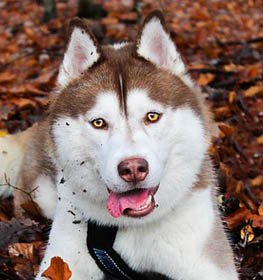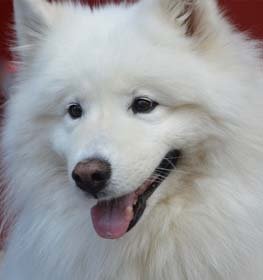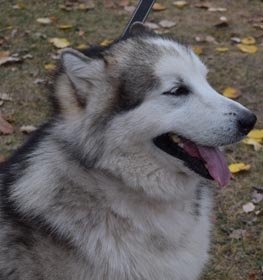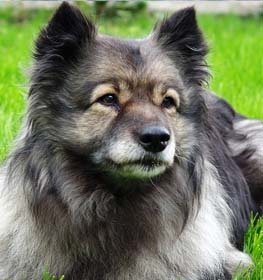Canadian Eskimo Dog Information & Dog Breed Facts
Collection of all the general dog breed info about Canadian Eskimo Dog so you can get to know the breed more.
| Group | Sled Dogs |
|---|---|
| Popularity Rank | 216 |
| Reviews | 2 |
| User Ratings | |
|
Compare the Canadian Eskimo Dog With Other Dogs
Select at least one dog breed to make the comparsion. | |
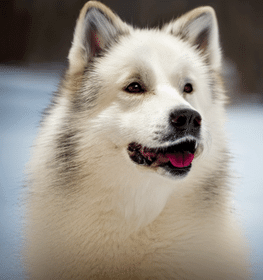 | |
| Origin | |
|
Other Names
What other names does the Canadian Eskimo Dog have?
| Canadian Inuit DogEsquimaux DogExquimaux HuskyQimmiq |
|---|---|
|
Breed Type
What type of dog breed is it? | Purebred |
|
Size
Is a Canadian Eskimo Dog small, medium or large dog?
How big do Canadian Eskimo Dog get? What is the average size of a Canadian Eskimo Dog? | Large |
|---|---|
|
Weight
How much does the Canadian Eskimo Dog weigh? How much should a Canadian Eskimo Dog weight? What is the normal weight of a Canadian Eskimo Dog? How much does a full-grown Canadian Eskimo Dog weight? | Male: 66-88 pounds (30-40 kg), Female: 40-66 pounds (18-30 kg) |
|
Average Weight
What is the average weight of a Canadian Eskimo Dog? | Male: 77 pounds (35 kg), Female: 53 pounds (24 kg) |
|
Height
How tall is the Canadian Eskimo Dog? Canadian Eskimo Dog height: | Male: 24-29 inches (61-73 cm), Female: 27-29 inches (68-73 cm) |
|
Average Height
What is the average height of a Canadian Eskimo Dog? | Male: 26.5 inches (67 cm), Female: 28 inches (70.5 cm) |
|
Price
How much does the Canadian Eskimo Dog puppy cost? What is the price range of this puppy? What is the average price of a Canadian Eskimo Dog in the United States? How much money is a Canadian Eskimo Dog?
Where to buy a Canadian Eskimo Dog with a good pedigree? | $1000-$1200 If you choose to purchase the Canadian Eskimo Dog, you should know that the mentioned amount of money is an average of the collected data from breeders’ sites and puppy finder places. If you have a Canadian Eskimo Dog for sale, please advertise it on a reliable website to make sure the Canadian Eskimo Dog gets to a happy place. |
|---|---|
|
Availability
How easy is it to get a Canadian Eskimo Dog? How many Canadian Eskimo Dog are there in the world? | Average: The Canadian Eskimo Dog is a commonly available dog breed. There is less risk of overbreeding compared to the very popular dogs. Of course, they may be more popular in some countries, and inbreeding may occur, so be careful. |
|
Intelligent Rank
How smart is the Canadian Eskimo Dog? Is the Canadian Eskimo Dog breed dumb or smart? | Average: It takes patience to teach this breed any tricks or commands, but the effort is worth it. They understand and remember new commands after an average of 25-40 repetitions.
The Canadian Eskimo Dog ranks average in the intelligence ranking of dogs. |
|---|---|
|
Trainability
Are Canadian Eskimo Dog dogs easy to train? Do they go well on dog training? How hard is it to train a Canadian Eskimo Dog? | Canadian Eskimo Dog dogs are quite easy to train. Sometimes they can be challenging, but if you're consistent in teaching new commands they will obey for sure. |
|
Watchdog Ability
Is Canadian Eskimo Dog good as a watchdog? Are they alert at night? | Canadian Eskimo Dog dogs are good watchdogs. Their main job is to observe and they're consistent in their effort. Good vocal cords and a sense of hearing belong to them. Usually, they're territorial and protective about their property, so the Canadian Eskimo Dog dogs will alert you if they sense something different.
|
|
Guarding Behavior / Territorial
Do Canadian Eskimo Dog dogs have aggressive behavior to protect their home/house/territory? Do they have guarding instincts? | Canadian Eskimo Dog dogs strongly protect their territory. This breed is a complete security guard, so you don't have to be afraid in case of danger. |
|
Temperament
What kind of personality does the Canadian Eskimo Dog have? What characteristics or traits does the breed have? | AlertIntelligentAffectionateLoyalBraveTough |
|---|---|
|
Sensitivity Level
How sensitive are they? Canadian Eskimo Dog sensitivity: | Sensitive: Canadian Eskimo Dog dogs don't like an irregular daily routine, noisy household, and frequent guest visits.
This breed's emotional level reflects their owner's feelings and they don't handle punishments well. |
|
Affection Level
How affectionate are they? Is a Canadian Eskimo Dog a good family dog? | Average to High: Canadian Eskimo Dog dogs are highly affectionate dogs. They like being involved in the family's life. This breed isn't considered an aloof dog. |
|
Social Needs
How much social interaction does the Canadian Inuit Dog need? Canadian Eskimo Dog social needs: | Canadian Eskimo Dog dogs are kinda antisocial. This breed doesn't like being around people all the time, they tolerate being left alone. |
|
Impulse to Wander or Roam
How likely is the Canadian Eskimo Dog to run away? Does this breed explore or wander a lot? Does Canadian Eskimo Dog roam? | Canadian Eskimo Dog dogs have high wanderlust potential, which means that this breed has a strong desire for exploring the world. Safer to walk them on a leash unless you teach them how to get back to you on command. This breed is also able to cause damage to your fence. |
|
Prey Drive
Do this canine have a strong prey drive? Does Canadian Eskimo Dog have high prey drive? | Canadian Eskimo Dog dogs have an average prey drive, which means that they don't have a high impulse to chase and catch something like a cat or any other small aminals, but it might happen. Training can help to achieve good behavior. |
|
Playfulness
How playful is this breed? | Average: Canadian Eskimo Dogs, like any other dog breed, like playing. Sometimes they bark in excitement for playing, but they are not the most playful dog breed. |
|---|---|
|
Barking
Do Canadian Eskimo Dog dogs bark a lot? Are they barkers/noisy? Why does my Canadian Inuit Dog bark? | Low to Average: The Canadian Eskimo Dog rarely barks. This breed could be a good choice if you're looking for a quiet breed. They don't bark unless there is a good reason.
Top reasons for barking: protection, alarm, fear, boredom, attention-seeking, greeting, separation anxiety, compulsive barking. |
|
Apartment Friendly
Is Canadian Eskimo Dog good as an apartment dog? Can they live in a flat? Can you have a Canadian Eskimo Dog in an apartment? | It is not recommended to keep the Canadian Eskimo Dog breed in the home. It does best in the garden, but if you do want to keep it indoors, it should be exercised thoroughly with long daily walks, so you can keep the Canadian Eskimo Dog indoors by introducing daily routines. |
|
Adaptability
Are they adaptable and easy-going? | Average: Canadian Eskimo Dog dogs adapt to lifestyle changes and different living environments quite okay usually. |
|---|---|
|
Tolerates Being Left Alone
How long can a Canadian Eskimo Dog be left alone? How long can you leave a Canadian Eskimo Dog alone? | Canadian Eskimo Dog dogs handle alone time quite well. They are not prone to have separation anxiety. |
|
Bite Force PSI
Does the Canadian Eskimo Dog has a hard bite?
What is the bite force of a Canadian Eskimo Dog?
How much bite force does a Canadian Eskimo Dog have?
How strong is a Canadian Eskimo Dog bite? | Between 200 and 400 PSI ⏺ Canadian Eskimo Dog bite force: Ordinary. Bite force Canadian Eskimo Dog measurements typically fall within the range of 200 to 400 PSI. The bite force of a Canadian Eskimo Dog is considered ordinary when compared to other dog breeds, but it is still quite powerful. This Canadian Eskimo Dog bite force PSI can cause bite wounds. Canadian Eskimo Dog bite PSI is not something that should be feared if the dog is well-trained and managed. To avoid any issues, it's essential to learn how to train a Canadian Eskimo Dog puppy not to bite from an early age.
The Canadian Eskimo Dog, and many others, have a fearsome presence because they have significant jaw strength, so it is important not to anger the dog and have it around strangers until it is fully trained. However, they are usually quite calm and good companions, they work well in families and are easy to care for. In conclusion, while the Canadian Eskimo Dog bite force is certainly an interesting aspect of the breed, it is important not to let it overshadow the many other reasons why these dogs are so loved and respected. With proper training and socialization, a Canadian Eskimo Dog can be a loyal and protective companion for your family. |
|---|---|
|
Biting Potential
Do Canadian Eskimo Dog bite humans? How likely are you to get bitten from the Canadian Inuit Dog? What are the odds of getting bitten by a Canadian Eskimo Dog? Why do dog bites happen?
| Low 🔽 The Canadian Eskimo Dog has a low chance of biting somebody. Top reasons for dog bite: protection, pain, excitement, herding instinct, being provoked. (Data based on the available online bite statistics.) |
|
Mouthiness
How much mouthing/nipping/play biting does the Canadian Eskimo Dog do?
| Canadian Eskimo Dog dogs have a higher than average tendency to nip, chew, playbite, or herd people. It's a common habit during puppyhood, not aggressive behavior. These "bites" don't hurt, but Canadian Eskimo Dog dogs need to be taught a good attitude. |
|
Health Issues
Is it a healthy or unhealthy breed? Do Canadian Eskimo Dog dogs have health problems or genetic diseases? | Canadian Eskimo Dogs tend to have more frequent health issues than other breeds. Regular vet check-ups are needed.
|
|---|---|
|
Health Problems
What genetic/health problems does the Canadian Eskimo Dog breed have? What are the health issues and concerns of the Canadian Eskimo Dog breed? Most common health risks of Canadian Eskimo Dog: | Cataracts Hip Dysplasia BloatArthritisHeatstroke |
|
Veterinarian Visits
How often does the Canadian Eskimo Dog breed need to go to the vet? How often should you take your dog to the vet? How often should the Canadian Eskimo Dog see the vet?
| Frequent The Canadian Eskimo Dog should have a complete physical check-up at least once (but preferably twice) per year. If your dog shows any symptoms, call your veterinarian. |
|
Life Expectancy
How long do Canadian Eskimo Dog dogs live? How old can a Canadian Eskimo Dog be? What is the age limit of the Canadian Eskimo Dog? How many years can the oldest Canadian Eskimo Dog live?
What is the average life expectancy / lifespan of a Canadian Eskimo Dog? How long is the lifespan of a Canadian Eskimo Dog? | 12-14 years The average lifespan of Canadian Eskimo Dog: 13 years |
|
Weather and Climate
Which weather condition is preferred by this dog? Can they tolerate hot or cold weather and climate? | Prefers average to cold weather conditions The Canadian Eskimo Dog can adapt to well to cold weather conditions, some dogs even can be a good mountain dog. |
|
Energy Level
How much energy does the Canadian Eskimo Dog have? What is the activity level of the Canadian Eskimo Dog?
| Canadian Eskimo Dog dogs are high-energy dogs. An active lifestyle makes them happy. |
|---|---|
|
Activity Requirement / Exercise Need
How much exercise does a Canadian Eskimo Dog need? How much exercise do Canadian Eskimo Dog dogs require per day?
Do Canadian Eskimo Dog dogs need a lot of exercises? | Canadian Eskimo Dog dogs need a lot of exercises. Long walks should be on a daily schedule. If you live an active life, this breed can be a good choice for you. |
|
Sleeping Need
How much sleep does the Canadian Eskimo Dog breed need? | Canadian Eskimo Dog dogs don't need too much sleep. They are energetic and desire to live active life. If you think naps are overrated, this breed can be the best choice for you. |
|
Average daily food consumption
How much food does a Canadian Eskimo Dog need? What dog products should I buy? How much food does a Canadian Eskimo Dog breed eat per day? What is good dog food for Canadian Eskimo Dog? How much food should I feed my Canadian Eskimo Dog? | 1.5 to 2.5 cups of high-quality dry food a day, divided into two meals. |
|---|---|
|
Weight Gain Potential / Prone to Obesity
How easy to gain weight for this dog? Canadian Eskimo Dog risk for obesity: | Low to Average: The Canadian Eskimo Dog has a low to the average risk for obesity. To make your dog happy and fit, feed him with quality dry dog food and live an active life together. Try to find the happy medium between exercise and feeding.
If you notice any weight gain, consult your veterinarian and make a diet plan. Reduce unhealthy food and snacks, and measure the Canadian Eskimo Dog weight regularly. |
|
Coat / Hair Types
What type of coat does the Canadian Eskimo Dog have? What does this canine coat/fur look like? | Dense |
|---|---|
|
Colors
What color is the breed's coat? What color are proper Canadian Eskimo Dog coats? | Black Red White Liver Grey |
|
Grooming
How to groom the Canadian Eskimo Dog and how often? How often should I take my Canadian Eskimo Dog to the groomer? | Average: The Canadian Eskimo Dog requires average grooming effort. Cutting the dog's hair by a professional groomer isn't essential. Brushing the dog's coat is useful to reduce shedding. Ears and eyes should be cleaned regularly to avoid infections. Don't skip the seasonal flea treatment too. Dog nail trimming and dog bath can be helpful sometimes. Check the local pet store for dog grooming supplies and find the best dog shampoo to keep its coat healthy and give your dog a pleasant experience of a dog bath. If you don't have the time, skill, or money to take care of your Canadian Eskimo Dog, search for a dog groomer or clipping service in your area and book an appointment. Maybe you're lucky to have a dog boarding service that includes grooming or walk-in dog bath places nearby. |
|
Shedding Level
How much do Canadian Eskimo Dog dogs shed? How to control, reduce and prevent the shedding of the Canadian Inuit Dog? Do Canadian Eskimo Dog dogs shed a lot? | Canadian Eskimo Dog dogs shed moderately. It's a natural process of the hair growth cycle. Regular brushing reduces the amount of hair that sheds. It mostly depends on their health status and breed type. |
|
Bath Time / Bathing Frequency
How often does the Canadian Eskimo Dog need a bath? How often should you give a Canadian Eskimo Dog a bath? Can I bathe my Canadian Eskimo Dog every day?
| 4-6 weeks Average. Experts recommended at least every 4-6 weeks for this family pup. According to a study, 56% of pet parents don’t bathe their dogs as frequently as they should, and 60% use the sniff test when deciding when it’s bath time.
Bathing your dog is beneficial to them in more ways than just one. It’s also a good time to look for unusual scratches, bumps, fleas, and other irregularities. When their hair is wet and flat against their body, these details are more visible. |
|
Hypoallergenic
Is the Canadian Eskimo Dog breed hypoallergenic? | No Canadian Eskimo Dog dogs don't do well with allergy sufferers by causing allergic reactions. Some dog breeds are even considered to higher possibility of an allergic response. Coat type isn't necessarily relevant, because most people are allergic to dander (flakes on the dog's skin) or saliva, not actually to dog hair. |
|
Stinkiness
How stinky is this dog? Why does it smell bad and how to get rid of the smell?
| Medium ⏺ The Canadian Eskimo Dog has an average chance of bad smell. Top reasons for dog stinkiness: infection of bad tooth/ear/skin folds, gas attacks. |
|
Drooling Tendency
Does the Canadian Eskimo Dog drool? | The Canadian Eskimo Dog is a perfect example of a low drooling tendency. If you dislike being covered by slobber spots on your clothes, the Canadian Eskimo Dog could be a good choice for you. Drooling is the unintentional saliva flowing outside of the mouth. It can be completely normal or a sign of a health problem. Certain dog breeds drool less than others, just like the Canadian Eskimo Dog.
If you notice any change in your dog's drooling habit, you should contact a vet as soon as possible. |
|
Pet Friendly
Are they pet-friendly dogs? How well do Canadian Eskimo Dog dogs get along with other pets? Are Canadian Eskimo Dog dogs good with pets? What is this canine temperament with other pets? | Canadian Eskimo Dog dogs are generally with other pets. |
|---|---|
|
Stranger Friendly
Are they aggressive or friendly towards/with strangers? Canadian Eskimo Dog temperament with other people: | Canadian Eskimo Dog dogs are average friendly towards strangers. |
|
Child Friendly
Are Canadian Eskimo Dog dogs kid-friendly? Are they good with young children? Canadian Eskimo Dog temperament with children: | Canadian Eskimo Dog dogs are kid-friendly dogs. This breed is a good choice if you have children. |
|
Cat Friendly
How well do Canadian Eskimo Dog dogs get along with cats? Are they good with kittens? What is this fido's temperament with cats? Can they be good with cats? Can the Canadian Eskimo Dog breed live with a cat? | Canadian Eskimo Dog dogs are average friendly towards cats. |
|
Dog Friendly
Is Canadian Eskimo Dog good with other dogs? Are they dog-friendly dogs? How well do Canadian Eskimo Dog dogs get along with other dogs? | Canadian Eskimo Dog dogs are average friendly towards other dogs. |
|
Good For First Time Owners
Is Canadian Eskimo Dog breed good for first-time owners? Do they make a good dog for novice owners? Is Canadian Eskimo Dog breed suitable for first-time owners? | Yes Canadian Eskimo Dog dogs are good for novice owners, due to their easy-going personality. |
|
Office Friendly
Are Canadian Eskimo Dog dogs good office canines? Do Canadian Eskimo Dog dogs make good office-friendly pets? Can they be office dogs? | No Canadian Eskimo Dog is not the best dog breed for office environment. |
|
Senior Citizens Friendly
Are they senior citizens friendly dogs? How well do Canadian Eskimo Dog dogs get along with the elderly people? What is the Canadian Inuit Dog temperament with senior people? Are Canadian Eskimo Dog dogs good for elderly owners? | Canadian Eskimo Dogs are usually recommended for elderly people. |
|
Service Dog
Are they good as service dogs? Can Canadian Eskimo Dog be a guide dog? Are they used as seeing-eye dogs? | Not really This breed generally not used as a service dog. A service dog is a term used in the USA to refer to any type of assistance dog specifically trained to help people who have disabilities, such as visual impairment, hearing impairments, mental disorders, seizures, mobility impairment, and diabetes. Service dogs are protected under the ADA (Americans with Disabilities Act).
Canadian Eskimo Dog is not the best breed for service purposes. |
|---|---|
|
Therapy Dog
Are they good as therapy dogs? Can Canadian Eskimo Dog be a therapy dog? Are they good anxiety dogs? Can a Canadian Eskimo Dog be an emotional support animal? | Not really This breed is generally not used as a therapy dog. A therapy dog is a dog that might be trained to provide affection, comfort, and love to people in hospitals, retirement homes, nursing homes, schools, hospices, disaster areas, and people with anxiety disorders or autism.
Canadian Eskimo Dog is not the best breed for therapeutic purposes. |
|
Detection Dog or Sniffer Dog
Are they good as detection dogs? Can Canadian Eskimo Dog be a sniffer dog? | Not really They are not typically employed for this type of work, but there may be exceptional cases. A detection dog or sniffer dog is a dog that is trained to use its senses (mostly its smell) to detect substances such as explosives, illegal drugs, wildlife scat, currency, blood, and contraband electronics such as illicit mobile phones.
Canadian Eskimo Dog is not the best breed for detection purposes. |
|
Search and Rescue Dog (SAR)
Are they good as SAR dogs? Can Canadian Eskimo Dog be a search and rescue dog? | Not really This dog breed is not typically used as a search and rescue dog. The use of dogs in search and rescue (SAR) is a valuable component in wilderness tracking, natural disasters, mass casualty events, and locating missing people.
The Canadian Eskimo Dog is not the best breed for SAR purposes. |
|
Boat and Sailor Dog
Are they good as boat dogs? Can Canadian Eskimo Dog be a boat dog? | Not really Canadian Eskimo Dog breed usually doesn't like being on a boat. Boat dogs were typically bred for their strength, stamina, and water resistance, as they were often required to perform tasks such as pulling in fishing nets, and jumping into the water to retrieve ropes or lines, or helping to move cargo. Sailor dog is a type of dog that was bred to accompany sailors on their voyages. They were typically used for three purposes: as a working dog, a watchdog, and as a companion. A boat dog is a term used to describe a type of dog that was traditionally bred and used as a working dog on boats. |
|
Cart Pulling or Drafting Dog
Are they good as cart pulling dogs? Can Canadian Eskimo Dog be a drafting dog? | Not really A drafting dog or draft dog is a dog bred and used for cart pulling. Dogs bred for this work have strong builds and qualities that are needed, strength and determination.
Canadian Eskimo Dog is not the best breed for drafting purposes. |
|
Fighting Dog / Military Dog
Where Canadian Eskimo Dog dogs used as fighting / military dogs in history? | Not really In history, this breed was not really used for combat dog. |
|
Gestation Length
How long is a Canadian Eskimo Dog pregnant?How long does it take to have puppies? How to tell if the Canadian Eskimo Dog breed is pregnant? | 60-64 days Reproductive cycle of the female Canadian Eskimo Dog: The first period called Proestrus lasts for about 9 days.
During this time the females start to attract males. You can notice by swelling vulva and bloody discharge. The second part is the Estrus when the female is receptive for the male. It lasts for about 3 to 11 days. The sign of the proestrus part is the soft and enlarged vulva. The discharge decreases and lightens in color. The third part is the Diestrus. Normally, it occurs around day 14. In this period the female’s discharge changes for vivid red and coming to its end. The vulva returns to average, and she will no longer permit mating. The fourth part called the Anestrus. The time frame between heat periods normally lasts about six months. |
|---|---|
| Litter Frequency | Once a year. More frequent breeding is not healthy. It is very important not to buy a dog from a puppy mill, where the needs of the pups and their mothers are ignored. It's an inhumane high-volume dog breeding facility, where puppies born several times a year. |
|
Litter Size
How many puppies can the Canadian Eskimo Dog have in a litter?
How many puppies can the Canadian Eskimo Dog breed have for the first time?
How many puppies does a Canadian Eskimo Dog have?
How many puppies can a Canadian Eskimo Dog give birth to? | 3-8 puppies |
|
AKC Group
Is Canadian Eskimo Dog recognized by the American Kennel Club? | Not recognized by the American Kennel Club. |
|---|---|
|
FCI Group
Is Canadian Eskimo Dog recognized by the Fédération Cynologique Internationale (FCI)? | Recognized by FCI in the Spitz and primitive types group, in the Nordic Sledge Dogs section. |
Canadian Eskimo Dog Pros and Cons
- Drooling Tendency: The Canadian Eskimo Dog is a perfect example of a low drooling tendency.
- Weight Gain Potential / Prone to Obesity: Low to Average: The Canadian Eskimo Dog has a low to the average risk for obesity.
- Watchdog Ability: Canadian Eskimo Dog dogs are good watchdogs.
- Tolerates Being Left Alone: Canadian Eskimo Dog dogs handle alone time quite well.
- Child Friendly: Canadian Eskimo Dog dogs are kid-friendly dogs.
- Senior Citizens Friendly: Canadian Eskimo Dogs are usually recommended for elderly people.
- Good For First Time Owners: Canadian Eskimo Dog dogs are good for novice owners, due to their easy-going personality.
- Health Issues: Canadian Eskimo Dogs tend to have more frequent health issues than other breeds.
- Hypoallergenic: Canadian Eskimo Dog dogs don't do well with allergy sufferers by causing allergic reactions.
- Apartment Friendly: It is not recommended to keep the Canadian Eskimo Dog breed in the home.
- Mouthiness: Canadian Eskimo Dog dogs have a higher than average tendency to nip, chew, playbite, or herd people.
- Impulse to Wander or Roam: Canadian Eskimo Dog dogs have high wanderlust potential, which means that this breed has a strong desire for exploring the world.
- Office Friendly: Canadian Eskimo Dog is not the best dog breed for office environment.
Canadian Eskimo Dog History
Many consider the Canadian Eskimo Dog, sometimes referred to as the Inuit Dog, the oldest indigenous dog breed of North America, which well adapted to the life it has led for many centuries in the Arctic Circle, laboring as a beast of burden and a hunter. According to the records Charles Darwin, along with many of the Old World explorers of North America, believed that the Canadian Eskimo Dog is closely related to the wild wolf, regarding the similarities in physical appearance between the two.
Surrounded by the barren environment, these dogs were seen as the key to survival for the Inuit people. The dogs served mainly as draught dogs to pull the heavy loads over massive distances. The Inuit tribes also used the dogs for hunting seals and other animals, consequently, the dogs were an indispensable part of the people’s lives. In fact, the Canadian Eskimo Dog is very far removed from the wild, with DNA studies proving that it was first domesticated several thousand years ago. Evidence also points to the fact that the Canadian Eskimo Dog and the Greenland Dog are basically the same breeds, yet this is still under debate. Nevertheless, it was proven to be true that the Canadian Eskimo Dog is a Spitz breed, and is closely related to the Greenland Dog. It is thought that the breed was first bred in an organized manner by the Thule people 4,000 years ago.
Unfortunately, as modernization reached the Arctic too, because of the spreading and increasing use of snowmobiles and the introduction of another faster, more effective sled dog breeds, like the Siberian Husky and the Alaskan Malamute, the population numbers of the Canadian Eskimo Dogs have decreased dramatically from 20,000 to the brink of extinction by the early 1960s. Moreover, a mass slaughter of the dogs, led by RCMP forces under government instruction, a fact which has been hotly debated and written off as conspiracy in some circles. In 1963, only one Canadian Eskimo Dog specimen remained registered with the CKC (Canadian Kennel Club), therefore the breed was declared extinct. Luckily, the breed had its fair number of fanciers on the North, and thanks to the Canadian government, the CKC, and the hard work of dedicated breeders, the Canadian Eskimo Dog has come back from the edge of extinction, however, the breed is still considered to be a very rare one. In the early 1970s, the Eskimo Dog Research Foundation was established by Brian Landoon with the objective of popularizing, reviving, and restoring the breed.
Nowadays, the Canadian Eskimo Dog is considered to be endangered due to the low population number. Moreover, the breed is mostly kept in the northern hemisphere. The Canadian Eskimo Dog is believed to be a very social, loyal, energetic, and trainable breed, nevertheless, it is rarely kept as a family companion, for the reason that a usual domestic setting cannot provide a sufficient amount of exercise for this athletic breed.
Latest Canadian Eskimo Dog Compares
Canadian Eskimo Dog Names
How old is my Canadian Eskimo Dog in human years?
You May Also Like
Rate The Canadian Eskimo Dog Breed
Canadian Eskimo Dog Comments, Reviews and Questions
- Brynn Anderson
Feb 6, 2022, 1:26:34 PM:
I don't have one yet but i am thinking about getting one also if anyone has one can you please send me a photo to my email address at [email protected] its ok if you email me just leave your name
- Afanash
Jul 26, 2020, 7:34:00 PM:
mine is very smart and is very healthy i named her viligance and she is so social she is easygoing even though i am a novice owner

